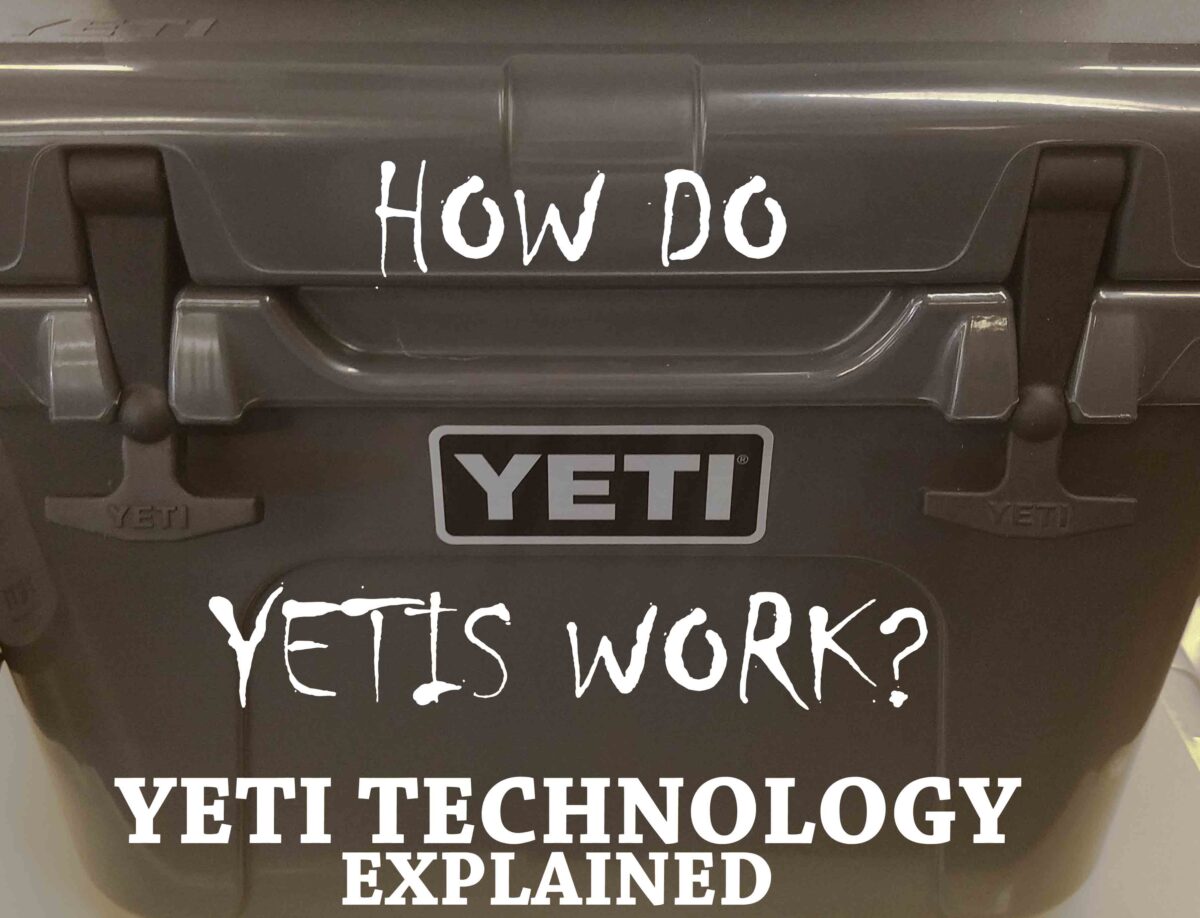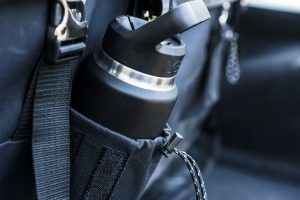
As an Amazon affiliate, we may earn a small commission if you purchase an item from one of our links. This is at no extra cost to you, and it helps to keep our site running.
Yeti has become one of the best brands in the last decade. They took the cooler and drinkware market and turned it upside down. The Yeti Tumbler and Rambler became something that everyone wanted. Before Yeti, there was no “IT” cooler or Tumbler to have, but now they are a must have, especially if you are into the outdoors. Their meteoric rise in popularity begs the question what exactly makes Yeti Tumblers keep drinks cold or hot so long?
How Do Yeti Tumblers Work?
Yeti Tumblers work by using vacuum sealed stainless steel. The vacuum between the stainless steel keeps out most of the heat by stopping heat conduction and convection. This plus the fact that stainless steel is a poor conductor allows the tumblers to keep beverages cold or hot so long.
The Yeti technology has been around for a very long time, but marketing and promotion wins. I remember the first time that I inquired about these magical cups. The answer I received was something along the lines of the cup keeps ice frozen for a very long time, like overnight.
I really thought, hmmph, who cares, I don’t need ice to last that long. But, the power of the brand took over, and I received a Yeti Rambler as a gift. It was my introduction into the brand. I soon realized the benefit of having a cup that could keep drinks cold for so long. I can make a drink with ice, and I can slowly drink it over several hours. This means that my drink is not watered down, and it keeps a better taste. The can lasts for hours in these long lasting tumblers. Iced water also lasted outside, even in the summer heat. The insulation works so well, and I was sold on the Yeti Tumbler.
Now I have the hat, the lifestyle sticker on my car, 3 coolers, and a Yeti tumbler. No seriously, I don’t have all that, but I do love my Yeti products.
Honestly, I love the brand and the products. Enough of the rambling, let’s get on to the Yeti technology.
How Are Yeti Tumblers Made

If we look at the design of the Yeti Tumbler, there is in inner and outer layer with a vacuum insulation in between. This means there is almost zero air in the middle.
This design minimizes two of the three types of heat transfer. Because there is no air, there is no convection and no conduction. There is only radiant heat transfer between the inner and outer walls.
Now this does not apply to the top which is just a plastic lid, but overall, this greatly reduces the surface area that allows for conduction and convection. This means that there is less heat transfer between a Yeti Tumbler and the contents inside of it.
First, we need to discuss what those are.
Conduction is the process by which heat or electricity is directly transmitted through a substance when there is a difference of temperature without movement of the material.
Convection is the movement caused within a fluid by the tendency of hotter and therefore less dense material to rise, and colder, denser material to sink, which consequently results in transfer of heat. The Yeti cup works by taking advantage of the science of those two principals.
If we look at how the design impacts conduction, heat transfer is greatly reduced because the inner wall has minimal contact with the outer wall. In addition, the material being used is a poor conductor of heat.
In a normal cup, the liquid or the ice inside the cup is exposed to only one layer which is the outer layer so it is a better conductor of heat than a Yeti Tumbler. Heat cannot efficiently conduct from the inside to the outside, and from the outside to the inside. Due to less transfer of heat, the ice stays colder longer.
If we look at how the design impacts convection, we need to consider the impact of air. Air is good at convecting heat, and when you have almost zero air in the middle of the Yeti, there is almost zero convection of heat. This of course, is only considering the steel walls, not the plastic top.
The last type of heat transfer is radiation. There is not much that can be done about the suns radiation, but the design can help reduce it. The interiors of each of the walls are coated/polished so that they reflect thermal radiation. The cups simply works on science.
These Yeti Tumblers are not cheap, but they are well branded, they are durable and sturdy. Every different style of cup that Yeti makes is great quality.
| 30 Ounce Tumbler | 30 Ounce Tumbler | 20 Ounce Tumbler |
|---|---|---|
 |  |  |
What Is A Yeti Tumbler Made Out Of?
Yeti Tumblers are made of 18.8 grade stainless steel which is corrosion resistant. This provides a durable and strong cup, and it gives it a nice, sleek, modern look.
What is inside a Yeti cup? Basically nothing due to its vacuum seal. This is the magic that keeps ice so long.
How Do Yeti Coolers Work?

Yeti coolers like this Yeti Roadie 20 work by using a manufacturing process called rotomolding or rotational molding. This is a process where liquid polymer is poured into a rotating hollow mold. After the plastic polymer cools a bit, more of it is added. This allows the cooler to be made with thick plastic walls that are uniform without any seams.
Because it lacks seams, it is more durable than a cooler that is made with multiple parts attached together. These are so durable, that if you put a padlock on it, they are certified IGBC bear proof.
There is a lot of insulation in these coolers. Yeti coolers have 2 inches of insulation in the walls and base and up to three inches in the lid. In addition the top interlocks with the body instead of just resting on the top. Normal coolers do not have near as thick insulation as the Yeti does. This helps the cooler keep ice for longer periods of time.
Inside is pressure injected polyurethane foam that does a great job of retaining cold. The rotomolding design, thick walls, and thick insulation allow these coolers to keep ice up to 7 days.
Regular coolers do not have this seamless design, and they do not have 3 inch thick insulation, therefore, they do not work as well.
This design also plays into why yeti coolers are so expensive.
What is inside a Yeti Cooler and how does it keep ice for so long?
There really is nothing special inside of a Yeti Cooler except for a thick piece of Styrofoam that is in the middle of the rotomolded plastic. The insulation is three inches thick which is a lot thicker than most coolers. Combine that with the rotomolded design, and you will get ice that stays frozen longer in the cooler. Simply put, it is just a better built cooler that is not cheaply made and put together.
Brief History of Yeti
Yeti was formed by two fishermen who wanted a tough cooler that they could take fishing. They wanted it to be tough, and it had to withstand punishment like no other cooler on the market.
They specifically wanted to be able to use it as a casting platform, so it needed to withstand the weight of a person on it. It also needed to keep ice frozen longer than a normal cooler.
One of them saw a rugged cooler manufactured from Thailand at a local retailer, and it got him thinking. This was the start of getting into the cooler business with the outdoors market.
Soon, they started an import business to market the cooler to fishing shops and outdoor equipment stores. They had some success, but it was not the exact product they were looking for. The manufacturer in Thailand could not accommodate their needs, so they had to look elsewhere.
They wanted a redesign of the cooler, so they took their idea to a manufacturer in the Philippines. From there, the Yeti prototype was made.
Please feel free to share your Yeti stories below. We would love to hear them!

Icey Tek, Icey Cool, and Engel were the first to market with these types of ice chests. Yeti was the Icey Tek distributor before branching off on their own and have since been acquired by a number of investment banks. These kinds of coolers have existed for along time in Australia and New Zealand. Thailand happened to be the place that largely manufactures them. A fiberglass version of these super coolers was also made just for outfitters on the Grand Canyon that took rafting clients on 27 day trips needing ice. Canyon Coolers (canyoncoolers.com) is a descendent of the Grand Canyon locals and the original Icey Cool brand. Icey Tek in America has since changed hands multiple times but still exists as does Engel.